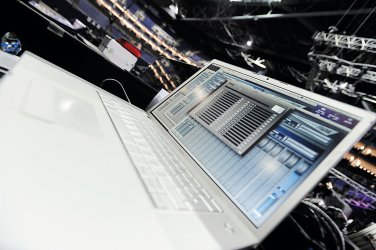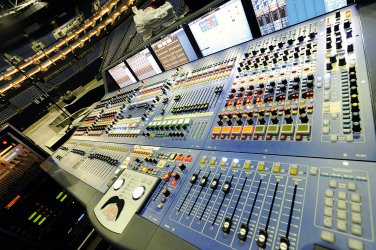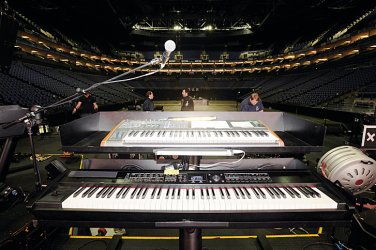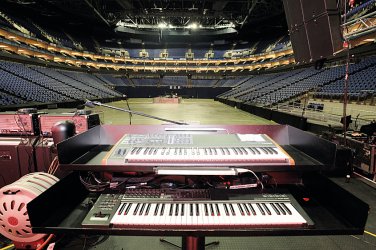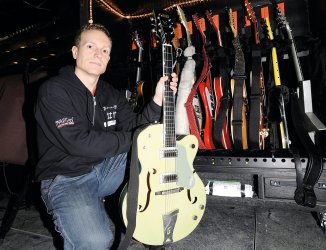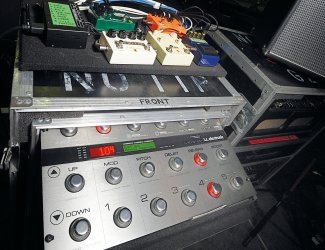- Joined
- Aug 15, 2019
- Messages
- 7,493
- Reaction score
- 143
- Points
- 63
Depeche Mode's Live Setup Revealed (Musicradar, 2010)
Depeche Mode's live setup revealed
By Future Music (Future Music) April 21, 2010
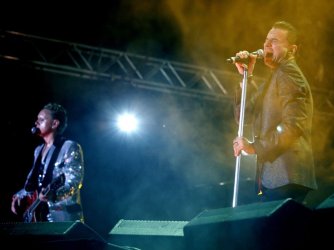
Martin Gore (left) and Dave Gahan on stage in 2009. (Image: © JEAN-CHRISTOPHE BOTT/epa/Corbis)
On 16 and 17 December, everyone's favourite electronic pop pioneers, Depeche Mode, checked into the enormous O2 Arena for the British stint of their massive Tour Of the Universe.
Taken with them were eight mega trucks, packed with gear selectively honed from over 20 years of touring experience and a 20-strong support team that's armed and ready to deal with anything the clash of live tour and hi-tech can inevitably throw up.
Put in charge of the hi-tech team is Paul Eastman, the keyboard technician and programmer for the tour and the man DM trust to make their sound happen on stage.
Things seem to have changed since Depeche Mode were a bunch of Emulators and that famous pair of Revox reel-to-reels running the show.
Paul Eastman: "Ah yes, there used to be two in case one went down. These days we're using the Radar system for the same job and have been for quite a few years too. Mainly because it's so solid. But the chap who used to press play on the tape machines for them back in the '80s ,JD, is still with them. He was around last night, in fact."
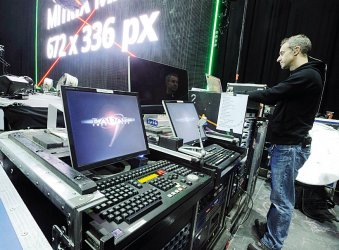
Depeche mode live setup
Paul Eastman at the helm of The Mode's Radar setup.
This looks like a monster rig. How long did you spend trying different options, trying to come up with the final set up?
PE: "The original plan for this tour was to take out all Martin [Gore]'s old analogue synth gear. This was because the record [Sounds Of The Universe] was all recorded with it. Increasingly over the past few years he's been working on a huge collection. For the new record they took those keyboards into the studio and obviously wanted to recreate those sounds. But obviously there's loads of problems with the gear: oscillators going out of tune, things breaking down and they've been plagued with trouble in the past with technology going down. So they wanted the old sound but - of course - wanted it to be rock-solid…
"In the past that meant they relied a lot on samplers: Emulators and the old Emax sampler, but all the samples were too grainy to use again and needed updating. So Kerry [Hopwood, Live Programmer/Musical Director] went back to the original two-inch tapes again and redid all the samples for this tour. So, we're using those new samples and some plug-ins for our sounds too.
"After we managed to convince the guys not to take all the old keyboards out we spoke to a few people about Muse Receptors and they told us that they were rock solid. So that seemed the best way to go. The last time they toured they were using Logic and the EXS sampler but they had a few glitches with it. I've used sequencers for playback for Snow Patrol and the Verve - we were using Logic - and they ran fine. But Kerry trusts the Radars. We used Pro Tools for the playback, during rehearsals but just before the tour started we printed the tracks to our pair of machines.
"Sample wise we're using Native Instruments Kontakt and Massive a lot too. We're also using a lot of GMedia ImpOSCar and Synthogy Ivory for pianos too. There are some sounds you can't get with the synths, so we use the samples for those, but there's a lot we can do and we try to use the synths as much as possible. Stripped is a good example of that. The big lead sound is Massive and ImpOSCar all layered up to create that main riff sound."
And the plug-ins are all hosted in Muse Receptors?
PE: "Yes, we've got six of them: two per keyboard player. Each pair is a main A and a backup B doing the same thing. Then we've got a custom-built switch box at the side of the stage so we can switch between each keyboard player's Receptor if something goes wrong."
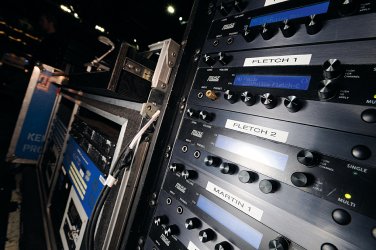
Depeche mode live setup
An April 2010 interview by MusicRadar with keyboard technician Paul Eastman and long-time guitar technician Jez Webb during the 2009-2010 "Tour Of The Universe".
Depeche Mode's live setup revealed
By Future Music (Future Music) April 21, 2010

Martin Gore (left) and Dave Gahan on stage in 2009. (Image: © JEAN-CHRISTOPHE BOTT/epa/Corbis)
On 16 and 17 December, everyone's favourite electronic pop pioneers, Depeche Mode, checked into the enormous O2 Arena for the British stint of their massive Tour Of the Universe.
Taken with them were eight mega trucks, packed with gear selectively honed from over 20 years of touring experience and a 20-strong support team that's armed and ready to deal with anything the clash of live tour and hi-tech can inevitably throw up.
Put in charge of the hi-tech team is Paul Eastman, the keyboard technician and programmer for the tour and the man DM trust to make their sound happen on stage.
Things seem to have changed since Depeche Mode were a bunch of Emulators and that famous pair of Revox reel-to-reels running the show.
Paul Eastman: "Ah yes, there used to be two in case one went down. These days we're using the Radar system for the same job and have been for quite a few years too. Mainly because it's so solid. But the chap who used to press play on the tape machines for them back in the '80s ,JD, is still with them. He was around last night, in fact."

Depeche mode live setup
Paul Eastman at the helm of The Mode's Radar setup.
This looks like a monster rig. How long did you spend trying different options, trying to come up with the final set up?
PE: "The original plan for this tour was to take out all Martin [Gore]'s old analogue synth gear. This was because the record [Sounds Of The Universe] was all recorded with it. Increasingly over the past few years he's been working on a huge collection. For the new record they took those keyboards into the studio and obviously wanted to recreate those sounds. But obviously there's loads of problems with the gear: oscillators going out of tune, things breaking down and they've been plagued with trouble in the past with technology going down. So they wanted the old sound but - of course - wanted it to be rock-solid…
"In the past that meant they relied a lot on samplers: Emulators and the old Emax sampler, but all the samples were too grainy to use again and needed updating. So Kerry [Hopwood, Live Programmer/Musical Director] went back to the original two-inch tapes again and redid all the samples for this tour. So, we're using those new samples and some plug-ins for our sounds too.
"After we managed to convince the guys not to take all the old keyboards out we spoke to a few people about Muse Receptors and they told us that they were rock solid. So that seemed the best way to go. The last time they toured they were using Logic and the EXS sampler but they had a few glitches with it. I've used sequencers for playback for Snow Patrol and the Verve - we were using Logic - and they ran fine. But Kerry trusts the Radars. We used Pro Tools for the playback, during rehearsals but just before the tour started we printed the tracks to our pair of machines.
"Sample wise we're using Native Instruments Kontakt and Massive a lot too. We're also using a lot of GMedia ImpOSCar and Synthogy Ivory for pianos too. There are some sounds you can't get with the synths, so we use the samples for those, but there's a lot we can do and we try to use the synths as much as possible. Stripped is a good example of that. The big lead sound is Massive and ImpOSCar all layered up to create that main riff sound."
And the plug-ins are all hosted in Muse Receptors?
PE: "Yes, we've got six of them: two per keyboard player. Each pair is a main A and a backup B doing the same thing. Then we've got a custom-built switch box at the side of the stage so we can switch between each keyboard player's Receptor if something goes wrong."

Depeche mode live setup

